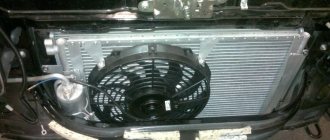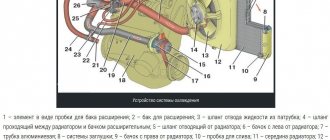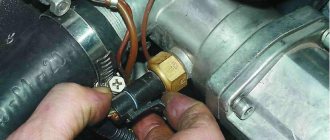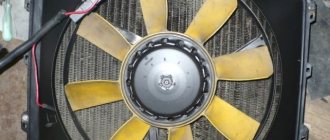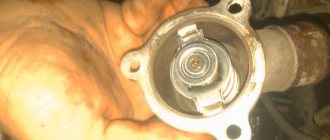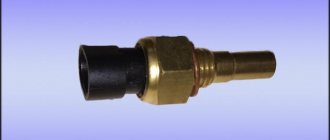The power unit (engine + manual transmission) VAZ 11183, 1.6 liter, is a four-cylinder, eight-valve injection engine running on gasoline. Gasoline is injected into the cylinders from four injectors in the intake manifold located close to the intake valves. There is only one camshaft in the cylinder head, it is located at the top.
To increase power, the height of the cylinder block was increased by 2.3 mm, compared to the previous similar engine 2111. The height of the block is 197.1 mm. In addition, the dimensions and configuration of the combustion chamber were changed. The materials of the head, block, crankshaft, camshaft, connecting rod, and piston have not changed. After making changes to the design documentation, the Volzhsky Automobile Plant produced a modification of the internal combustion engine with increased power (82 hp) under the index 11183-50 with an electronic throttle control drive.
At what temperature does the fan turn on?
Lately I have to drive my Kalina quite rarely, and I noticed a peculiarity that the fan does not turn on at all.
Although you have to stand in traffic jams, and the temperature outside is above +30 degrees. We began to have doubts about the performance of the fan or the electrics responsible for its operation. I decided to check everything at idle when the car was parked. I started it up and waited until the engine warmed up to a high temperature. At this time, I opened the hood and began to observe the fan. After about 20 minutes of engine operation, the coolant temperature gauge needle approached 100 degrees, but the fan still did not want to turn on. I already thought that something was wrong with the car, but as soon as the needle rose slightly above 100 degrees (about 102) , the fan started working, and I breathed a sigh of relief. The photo above shows exactly the moment it was turned on. After reading specialized forums, I came to the conclusion that this temperature should be in order to send a signal from the ECU.
I also came across quite a lot of opinions that it is better to set a lower response threshold, for example, using the “Tropic” mode on the “State” on-board computer. It is possible that in some cases this will be justified, but I think that constantly turning on this mode will not lead to anything good. Moreover, in the summer the engine often heats up to 95-98 degrees and this temperature can be considered normal. And if the blades start spinning when such a threshold is reached, then the electric motor will definitely not work in this mode for a long time.
It is very difficult to overheat the engine when the fan is operating normally. Although there was one case with my Kalina, when in abnormal heat (+42 in the shade) I had to trudge a couple of kilometers behind a scraper. I mentioned this incident once. After reaching the critical temperature, a constant long sound signal from the instrument panel is triggered and the warning lamp lights up. At this moment, a signal is sent to the standard BC and it records error 6. You can read more about this here: Error codes of the on-board computer and self-diagnosis of the instrument panel.
In my case, after the overheating alarm went off, I immediately managed to drive out onto a flat section of the road and the needle immediately dropped to the normal level. Thank God, there were no consequences for the engine, but it is better to avoid such situations.
Source
Why does a 16 valve engine take a long time to warm up?
- Registration
- Entrance
- To the beginning of the forum
- Forum Rules
- Old design
- FAQ
- Search
- Users
People, the car is VAZ-2112. The following problems arose with warming up: the temperature outside was -15 degrees, it started without problems, it warmed up to 30-40 degrees quite quickly at idle, then driving. Even during a long drive around the city, the temperature does not rise above 79-81 degrees, it heats up slowly, i.e. in about 20 minutes of driving it reaches 80 and stabilizes. At the same time, the stove works perfectly and at some point even stops turning the fan altogether.
What is this - a bug or a feature of the 16 valve engine? And if these are problems, what are they: is the thermostat or temperature sensor going crazy, what should I even look at?
But then why can it hang at 80 degrees for as long as desired? A friend of mine at work has a VAZ 21102 - while he drives to work (20 minutes) the engine turns 90 degrees, so I decided to ask.
When you use a mercury thermometer to measure the temperature in identically heated cars in the same place, then you can judge the operation of the thermostat. The temperature sensor readings for the instrument scale may vary with an error of +5 - -10%. So think about what this means. Draw your own conclusion too.
I'm looking at the on-board computer. That’s why this question arose, but my dashboard is completely lying and doesn’t turn red: when it shows 50, then the on-board readings are already 70-80.
Using the BC readings, you can quite accurately determine the temperature at which the large circle begins to open. Your thermostat valve appears to be opening earlier than it should.
I'm looking at the on-board computer. That’s why this question arose, but my dashboard is completely lying and doesn’t turn red: when it shows 50, then the on-board readings are already 70-80.
Using the BC readings, you can quite accurately determine the temperature at which the large circle begins to open. Your thermostat valve appears to be opening earlier than it should.
And that the on-board computer does not take the temperature from the same sensor? I always thought it was from there.
Well, okay, I'll get back from work in the evening and dig into the electrical circuit.
By the way, since the question is about the temperature regime of the engine, can you also clarify what are the temperature parameters for turning the cooling fan on and off?
I don’t remember at what specific temperature the fan turns on and off, but the controller takes the data for this from the temperature sensor screwed into the thermostat.
2 VadiK_055
Everything is normal for you (2112 engines heat up while driving much slower than 2111 engines), except for the value at which the coolant temperature stabilizes. Very similar to early opening of the thermostat. In general, in winter, with prolonged uniform movement, the coolant temperature stabilizes at the temperature at which the thermostat begins to open. During city driving, however, this does not work; in the city you can drive until the Carlson triggers. You can check the operation of the thermostat during warm-up after a long period of parking by feeling the pipe extending from the thermostat to the bottom of the radiator. You need to feel 5-10 cm from the thermostat itself. The temperature at which the pipe begins to warm is the temperature at which the thermostat begins to open. The method is not very accurate, but it allows you to evaluate the operation of the thermostat.
The on-board computer takes temperature readings not from the sensor at all, but from the controller. That, in turn, receives data from the sensor. There are two sensors, one provides information to the display meter in the instrument panel, the other to the controller. A bookmaker, in general, can be called a computer very conditionally. The simplest ones can only calculate fuel consumption according to the controller data and nothing more. Everything else they simply INDICATE. Indicate data received from the controller. Well, I got distracted.
The 2112 engine has a radiator fan turn-on temperature of 100 degrees and a turn-off temperature of 96 degrees. It seems that on the old firmware there were 101 and 97, but I don’t know for sure.
_________________I'm not WEAK-willed, I'm STRONGLY lazy.
I do this: - go into the garage (unheated brick, but it’s still warmer there than outside) - start the car (2112 16V) - open the garage, roll out, close the garage (6-7 minutes), the temperature rises by this time to 50 -55 degrees
Operation of the Lada Kalina cooling system
Under the Kalina brand, VAZ produces a series of car models with different body styles, equipped with injection engines with 8 valves. All machines have the same standard cooling system, the diagram of which is shown below.
Engine cooling system diagram:
- 1 — heater radiator;
- 2 - expansion tank;
- 3 - air valve;
- 4 — thermostat;
- 5 — fan switch sensor;
- 6 - fan;
- 7 — protective panel;
- 8 — crankcase cover;
- 9 - pump;
- 10 — stove tap;
- 11 - hose;
- 12 - clamp;
- 13 - gasket;
- 14 — air intake;
- 15 - hot air flow from the stove.
The cooling system has two circuits: large and small. While the engine is warming up, the thermostat circulates antifreeze in a small circle: pump - engine jacket - expansion tank. When the antifreeze temperature reaches the desired value, the thermostat opens a large circuit through the radiator. When the temperature arrow on the instrument panel moves into the green zone, the car is ready to drive. In the case of a strong cold oncoming air flow, the thermostat will gradually block the flow of antifreeze into the radiator and vice versa, as the temperature rises, the device will open more. When the heating of the antifreeze reaches a point equal to 950C, the fan switch sensor comes into operation.
Which thermostats to choose for VAZ (Lada) Kalina?
Last month, PartReview users preferred WEEN. 29% of positive votes belong to this manufacturer.
LUZAR thermostats took second place – 14%.
Gates closes the top three with 4% of the votes.
In the general rating of thermostats, which takes into account the opinions of owners of different brands and models of cars, these brands occupy the following positions:
- WEEN received 1st place, PR score – 91. Data from 36 reviews and 111 votes are taken into account.
- LUZAR took 7th place, with a PR score of 66. Based on 36 reviews and 186 votes.
- Gates is ranked 9th with a PR score of 53, based on 24 reviews and 73 votes.
Operating temperature of 8-valve
The normal operating temperature for eight-valve engines on Kalinas and Grants is exactly 90 ºC . But owners complain that sometimes it has difficulty reaching 80 degrees even in warm weather. The reason lies in the thermostat - it opens fully at a temperature of 85 degrees. Moreover, the permissible deviation from this value is very large - ( 85±8.3 ) ºС.
In other words, the run-up is 77..93ºС .
But the fuel mixture can only ignite normally if the engine temperature is about 90 degrees . This is the value stored in the electronic control unit. If the temperature is too low, the mixture becomes richer (the amount of gasoline increases). This is the main problem that occurs when the temperature drops. And in winter the heater works worse.
Your case
Temperature diagram . Normal operating temperature is at 90 on the instrument panel.
In your case, the thermostat is most likely stuck, usually stuck in the middle. In this case, either repairing or replacing the thermostat will help.
A stuck thermostat valve is a typical malfunction of the engine cooling system.
That is, the liquid that has not yet been heated is supplied to the cooling radiator and blown by a strong wind flow. Indeed, with an increase in air temperature, the problem will partly go away. That’s why they used to put cardboard on it and drive like that for years. But we don't recommend doing this.
Solution
The problem of low temperature of the engine cooling system can be eliminated by installing a thermostat that opens at 92ºС . The WAHLER 3091.92D element performs excellently .
Original packaging of Wahler 3091.92d thermostat.
The element itself - the opening temperature is stamped on the body.
You just have to disassemble it and transfer the inside to Kalina’s original thermostat.
Looking for a reason
Start checking with the electric motor. To do this, disconnect the electrical wires from it and connect it directly to the battery, observing the polarity. If the fan does not turn on, that is the problem. If it works, you need to look for another reason.
Check all contacts on the connectors, and then the relay and fuse. They are located in an additional mounting block, which is located to the right of the instrument panel near the lower heater air duct.
The fuse (50 A) can be checked with a tester; it is better to take a relay that is known to be working and install it in the appropriate socket. If the problem is not solved, move on.
Checking the temperature sensor. To do this, warm up the engine to operating temperature, turn it off and disconnect the sensor. It is located on top of the thermostat housing. When the sensor is disabled, the controller must independently start the fan to operate continuously.
Start the engine and wait for the fan to turn on. If the coolant temperature has reached a critical value and the fan does not turn on, you need to look for a break in the electrical wiring.
Do I need to change the fan?
If you have determined that the problem is in the fan itself, or rather in its electric motor, you can try to repair it. Most often, it stops working due to failure of the brushes, or due to problems with the rotor bearings. Less often the collector becomes unusable or a break occurs in the winding.
If the fan cannot be repaired, it must be replaced.
Under no circumstances should you drive a car with a non-functioning fan. Overheating of the engine will inevitably lead to the destruction of the rubber hoses of the cooling system, gaskets, and also threatens the failure of parts of the piston group.
Why do you need DVV?
When driving for a long time in a low gear or idling for a long time, the radiator does not receive sufficient airflow. As a result, the coolant temperature rises sharply and the liquid may boil. Frequently occurring engine overheating can cause premature wear of the piston group of engine cylinders. When exposed to high heat, the surfaces of rubbing parts begin to lose their strength characteristics, which causes their destruction. In the end, this will lead to a major overhaul of the engine, accompanied by large financial costs.
To protect the car from such phenomena, the radiator is equipped with a fan, which, through forced airflow, sharply lowers the temperature of the liquid in the engine cooling system. The fan will turn on when the temperature approaches the boiling threshold of the antifreeze. The function of the sensor is not limited to regulating the operation of the electric fan. The fact is that information about the temperature of the antifreeze, entering the “brain center of the car” - the ECU, is processed and converted into commands that adjust the proportional composition of the fuel mixture, the moment of spark formation and other operating modes of engine instruments. The productive operation of the injection engine of the Lada Kalina largely depends on the serviceability of the internal combustion engine.
The importance of using antifreeze
Monitor the antifreeze level
External engine overheating can occur for a number of reasons, and one of the main ones is insufficient antifreeze in the cooling system. Antifreeze can leak out easily because it has the structure of a regular liquid. Therefore, it is necessary to constantly monitor the integrity of the hoses and their fastenings.
Try to pay attention to the surface where the car has been standing for a long time. Light spots on it indicate a coolant leak. If such signs are detected, it is necessary to urgently check the integrity of all elements of the cooling system. If antifreeze leaks into one of the engine cylinders or into the oil compartment, serious complications are quite possible.
If you do not use antifreeze, but fill the cooling system with distilled water, you should not use hard water, which contains a large amount of minerals and salts. You risk ruining even a new thermostat after only 3-4 thousand kilometers.
Some improvements to the Kalina water cooling system
Today, drivers use several methods to upgrade the cooling system. For example, the factory cooling system is completely redone. At the same time, Kalina is equipped with a completely new thermostat with six holes. Thus, the coolant temperature becomes more stable. The cabin becomes much warmer.
To reduce the likelihood of failure of the cooling system, the Lada Kalina is equipped with a special filter through which coolant is supplied.
The installation of a furnace tap is also ideal. In addition, an additional pump is installed in the fluid supply system. As a result, antifreeze will move quickly through the channels, in winter the Kalina will receive enhanced heating, and in summer the engine will never overheat.
Video
The car engine is overheating.
Overheating of a car engine is a problem that every driver can face. In this article we can learn: - how to notice in time that the engine has overheated; — why the engine heats up in general and in certain situations; — what to do if the engine overheats.
To understand the essence of the issue, it is necessary to consistently read all the explanations of an experienced auto mechanic.
Design and principle of operation of DVV
The coolant temperature meter on Kalina is a brass cylinder in the form of a nut skirt, at the bottom of which there is an installation thread with a sealing washer made of aluminum or copper. At the top of the device there is a plastic cup with two detachable terminals inside. One of them is connected to ground (minus). The second contact (plus) is connected by a wire to the ECU.
Inside the housing there is a bimetallic plate that fits tightly to the inside of the tip, which is washed by coolant. When a critical heating level (90-950C) is reached, the bent plate straightens and closes two contacts. Current begins to pass through the terminals and enter the electronic control unit (ECU). The unit gives commands to deplete the fuel mixture entering the injector and turns it on via the EV relay.
As soon as the temperature of the liquid in the thermostat begins to drop, the fan will turn off. Such a self-regulating system constantly maintains the optimal antifreeze temperature at an acceptable level, which means the engine itself will not overheat.
At what temperature does the fan turn on?
Lately I have to drive my Kalina quite rarely, and I noticed a peculiarity that the fan does not turn on at all. Although you have to stand in traffic jams, and the temperature outside is above +30 degrees. We began to have doubts about the performance of the fan or the electrics responsible for its operation. I decided to check everything at idle when the car was parked. I started it up and waited until the engine warmed up to a high temperature. At this time, I opened the hood and began to observe the fan. After about 20 minutes of engine operation, the coolant temperature gauge needle approached 100 degrees, but the fan still did not want to turn on.
I already thought that something was wrong with the car, but as soon as the needle rose slightly above 100 degrees (about 102) , the fan started working, and I breathed a sigh of relief. The photo above shows exactly the moment it was turned on. After reading specialized forums, I came to the conclusion that this temperature should be in order to send a signal from the ECU.
I also came across quite a lot of opinions that it is better to set a lower response threshold, for example, using the “Tropic” mode on the “State” on-board computer. It is possible that in some cases this will be justified, but I think that constantly turning on this mode will not lead to anything good. Moreover, in the summer the engine often heats up to 95-98 degrees and this temperature can be considered normal. And if the blades start spinning when such a threshold is reached, then the electric motor will definitely not work in this mode for a long time.
Description
As you know, any Priora and Kalina have a cooling system that ensures normal engine operation and helps prevent overheating. One of the devices that allows you to cool the power unit is a fan sensor, upon the signal of which the ventilation device should turn on. On Kalina, this controller is designed to activate the fan when the engine temperature reaches a certain point. Thanks to the fan, which must turn on based on a signal from the controller, the engine temperature will always be normal and will not exceed the permissible threshold. If the device does not work, the fan will not turn on, and the engine may overheat.
Sensor connection diagram in the cooling system
Symptoms of a broken temperature/fan sensor
There is a common opinion among Lada Kalina owners that the DVV is a fairly simple device in design, and therefore it practically does not break. Actually this is not true. Signs of a malfunction of the internal combustion engine appear as follows:
- The EV does not turn on when the temperature arrow is in a critical position in the red zone on the instrument panel;
- increasing engine speed in idle mode;
- the occurrence of detonation in the cylinders;
- the appearance of jets of steam from under the hood.
The fan is attached to the radiator:
If overheating occurs
When your engine suddenly overheats or your cooling system suddenly stops working, the following actions can prevent catastrophic consequences.
If you can park safely on the side of the road, park right next to the curb and turn off the engine. As soon as the engine temperature arrow has left the danger zone, and the temperature is in optimal values, you can continue driving.
To help your unit return to normal faster, it is better to open the hood. This way the heat can escape very quickly. You should do this extremely carefully - there is a risk of getting burned.
There is no need to attempt to open the radiator cap. If you open it, steam and coolant will come out of the radiator. It is under pressure - you could be seriously injured.
Diagnostics of the cooling system in your own garage
EV failure can be caused by several reasons. They need to be identified and eliminated one by one. Before working on the sensor, you need to check the following points.
Integrity of wires leading to the sensor
Visually and tactilely check the condition of the insulating coating of each of the two wires. If there is no damage to the polymer sheath of the wires, they are “ringed”. That is, use a multimeter in ohmmeter mode to check the presence of resistance at the ends of the conductors.
Electrical fan operation:
Cleanliness of the contact group
The cable with the chip is disconnected from the contact cup of the fan sensor. Visually check the condition of the terminals. If oxidation of the contacts is detected, they are cleaned with fine sandpaper. The connection of the connectors is restored.
Voltage
On the removed chip from the DVV, check the voltage with a multimeter. One of the contacts should show “0” V, and on the other terminal the device on the screen should display a reading of 5 V. During the test, the engine should be running in idle mode.
Fuse
If it is determined that there is no voltage at the positive terminal, then it is necessary to check the integrity of the fuse installed in the break in the supply wire of the sensor. A bad fuse is characterized by a burnt-out metal track. Then you need to install a new part and test its operation.
From the fuse panel, remove the relay from its sockets. Remove the plastic box by pressing the side clips. If burnt contacts are detected, the device is replaced with a new relay.
Electric fan
Check the condition of the fan contact group. The EV is connected with additional wiring to the battery. If the fan does not turn on directly, then the problem is in its electric motor or bearing.
If all diagnostic stages do not reveal any malfunctions, then you need to check the fan switch itself.
Where is the sensor located and how does it work?
Fan switching sensors are located on the cooling system elements. The installation point is located in the path of the fluid flow supplied from the engine jacket to the radiator. This is due to the fact that the liquid in this line will have the highest temperature.
VAZ car sensor installed at the bottom of the radiator
Possible installation locations:
- thermostat housing outside the valve;
- cylinder head;
- lower radiator hose;
- side of the radiator.
On some vehicles, the sensor is combined with a coolant thermometer. The fans are turned on by the control unit based on temperature data. In this case, there is an additional sensor on the radiator that is used to operate the climate control or air conditioning. Triggering of any of the devices turns on both fans (on the engine and air conditioner radiators). A similar solution is found on Japanese cars.
On cars, two fan switching sensors can be used, located at the inlet and outlet of the radiator pipes. This scheme allows you to maintain the temperature in a narrow range.
Varieties
On cars, the following types of sensors are used to turn on the fan:
- bimetallic;
- waxy;
- thermistor;
- a sensor that operates on a circuit break or short circuit.
The first two types of sensors have an electromechanical operating circuit and can be of two varieties:
- single-speed, equipped with a single contact group that controls the fan in one temperature range;
- two-speed, equipped with a pair of contact groups configured to operate at different temperature ranges.
Regardless of the type, the sensors are a metal housing equipped with a thread. The body material used is non-ferrous metals based on copper (bronze or brass), which provide increased thermal conductivity. There is a hex key on the body that is used for installing the part. The wiring connector is located on the top of the sensor.
Bimetallic sensor
A bimetallic sensor contains a metal plate. In normal condition the contacts are open. As the plate heats up, it deforms and closes the circuit, supplying a control signal to the impeller motor turn-on relay. There are sensors that activate the fan motor directly without a relay. When the liquid cools, the plate returns to its original shape and the current supply to the motor stops.
The principle of operation of the sensor on a carburetor engine
Wax sensor
Sensors were produced for which wax or ceresite (or another substance with a significant coefficient of thermal expansion) was used as a working substance. As it warmed up, it expanded and shifted the metal membrane associated with the contacts. As it cooled, the volume of the wax decreased, and under the action of the spring the contacts opened.
Sensor with wax element
Thermistor sensor
The thermistor sensor works on the principle of changing the resistance of a resistor installed in the fluid flow. The temperature change is recorded by an electronic unit, which recalculates the temperature value in accordance with the schedule.
Sensors that operate on open circuit or short circuit
Devices that turn on the fan when the circuit breaks are often found on Japanese-made cars. You can check the sensor type by removing the plug. When the block is removed from the tensile sensor, the fan will turn on.
At what temperature does the fan switch trigger?
The temperature range of the sensor response depends on the type of engine power supply. On carburetor cars, devices with a switching range of 82-110 ºС are used. The activation temperature is stamped on the body of the part. On cars of the same model, there may be sensors calibrated for different temperatures.
Replacing coolant temperature sensors on Kalina
Welcome! Coolant temperature sensors - if we talk specifically about the Lada Kalina car, then there are only two sensor data in it, one goes to the controller (This is the brain, to put it simply), and the other to the device, that is, one sensor shows what the temperature of the coolant in the car is and displays this is all for the device, and another one (which gives readings to the controller) turns on the cooling system fan when the car is boiling, and also regulates the fuel-air mixture (Simply put, when the car is cold, thanks to this sensor it will warm up faster, because the sensor richens the mixture and the temperature immediately rises), both of these sensors are important and if they fail they will cause quite a lot of trouble, especially for the sensor that gives readings to the device, if it stops working, then you simply will not know the temperature of the coolant and in connection with which you can overheat the engine.
Note! To replace both sensors (you will most likely only replace one), stock up on: Wrenches, as well as sockets and a wrench for them, you will also need a multi-meter (This is in case you want to check the functionality of the old sensor ) and a screwdriver!
Checking the electrical circuit
Malfunctions in the cooling circuit system are not always associated with faulty sensors; in 70% of cases, the problem is a violation of the integrity of the wires. On Kalina, the block often suffers; the thin plastic at the entrance to the block rots and cracks. After disconnecting the pads from the sensors, the throughput of the circuits is always checked before dismantling the latter.
- The ignition is turned off and the block is removed from the sensor.
- The tester probe (multimeter) is connected to output “B” of the block, the second tester probe is located at ground.
- The ignition turns on.
- The monitor should display a voltage in the range of 4.8–5.2 V. These are indicators of the complete circuit.
- Similarly, the performance of the circuit is checked by resistance. The tester probe is connected to terminal “A” on the block, the second one is connected to the ground of the car. The operating circuit will show a resistance of less than 1 ohm.
If the voltage does not correspond to the operating voltage, then the circuit is checked for an open circuit. The tester probe is connected to terminal “B” on the block and terminal “39” on the controller; if the voltage is normal, then there is a malfunction in the control unit.
The cooling circuit of the Lada Kalina engine is equipped with two temperature sensors, the correct operation of which determines the performance of the engine and its service life. You can diagnose and replace the control elements yourself; it will take about an hour of time and a little skill.
Removing the fan sensor
DVV is a non-separable product and cannot be repaired. However, to ensure that it is fully operational, it must be removed from the vehicle. To do this proceed as follows:
- The car is placed on level ground with the handbrake lever raised.
- Start working after the engine has completely cooled down, removing the terminals from the battery.
- Having squeezed out the plastic clip, remove the chip with the cable from the DVV glass.
- Remove the plug from the expansion tank, otherwise when the sensor is removed, a small amount of antifreeze will splash out.
- Use a spanner wrench or a 19 DVV socket to unscrew it from the seat. If the thread does not lend itself well, then apply WD 40 lubricant under the sensor nut (you can buy it at any auto store or gas station).
How to check DVV yourself
A situation may arise when the sensor is triggered “every time”. To make sure it works, they use a home-grown method for checking the DVV. Proceed as follows:
- The sensor is suspended on a suitable cord or insulated wire.
- The two contacts of the sensor are connected to a multimeter in resistance measurement mode.
- The tip of the part is lowered into an electric kettle with cold water. The initial reading of the device should be 4.5 kOhm.
- The kettle is turned on. As the temperature increases, the resistance value will decrease sharply.
- Before the water boils, the sensor resistance will be 177 ohms. If there is a discrepancy with the actual readings, the DVV must be replaced.

